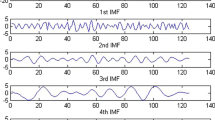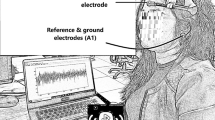Abstract
In last few years, the research community has shown interest in the development of Brain Computer Interface which may assists physically challenged people to communicate with the help of brain signal. The two important components of such BCI system are to determine appropriate features and classification method to achieve better performance. In literature, Empirical Mode Decomposition is suggested for feature extraction from EEG which is suitable for the analysis of non-linear and non-stationary time series. However, the features obtained from EEG may contain irrelevant and redundant features which make them inefficient for machine learning. Relevant features not only decrease the processing time to train a classifier but also provide better generalization. Hence, relevant features which provide maximum classification accuracy are selected using ratio of scatter matrices, Chernoff distance measure and linear regression. The performance of different mental task using different measures used for feature selection is compared and evaluated in terms of classification accuracy. Experimental results show that there is significant improvement in classification accuracy with features selected using all feature selection methods and in particular with ratio of scatter matrices.
Access this chapter
Tax calculation will be finalised at checkout
Purchases are for personal use only
Preview
Unable to display preview. Download preview PDF.
Similar content being viewed by others
References
Anderson, W.C., Stolz, E.A., Shamsunder, S.: Multivariate autoregressive models for classification of spontaneous electroencephalographic signals during mental tasks. IEEE Trans. Biomed. Eng. 45(3), 277–286 (1998)
Babiloni, F., Cincotti, F., Lazzarini, L., Millan, J., Mourino, J., Varsta, M., Heikkonen, J., Bianchi, L., Marciani, M.G.: Linear classification of low-resolution EEG patterns produced by imagined hand movements. IEEE Trans. Rehabil. Eng. 8(2), 186–188 (2000)
Basseville, M., Benveniste, A.: Sequential segmentation of nonstationary digital signals using spectral analysis. Information Science 29(1), 57–73 (1983)
Richard, O., Peter, E., David, G.: Pattern Classification, 2nd edn. Wiley India (P) Ltd
Diez, P.F., Mut, V., Laciar, E.: A location of the empirical mode decomposition to the extraction of features from EEG signals for mental task classification. In: 31st Annual Int. Conference of the IEEE EMBS, Minnesota, pp. 2579–2582 (2009)
Fisher, A.R.: The use of multiple measurements in taxonomic problems. Ann. Eugen 7, 179–188 (1936)
Freeman, W.J.: Comparison of brain models for active vs. passive perception. Information Science 116, 97–107 (1999)
Garrett, D., Peterson, D.A., Anderson, C.W., Thaut, M.H.: Comparison of linear, nonlinear, and feature selection methods for EEG signal classification. IEEE Trans. Neural Syst. Rehabil. Eng. 11(2), 141–144 (2003)
Graimann, B., Huggins, J.E., Schlogl, A., Levine, S.P., Pfurtscheller, G.: Detection of movement-related desynchronization patterns in ongoing single-channel electrocardiogram. IEEE Trans. Neural Syst. Rehabil. Eng. 11(3), 276–281 (2003)
Guyon, I., Elisseeff, A.: An Introduction to Variable and feature Selection. Machine Learning Research (3), 1157–1182 (2003)
Guyon, I., Weston, J., Bernhill, S., Vapnik, V.: Gene Selection for cancer classification using support vector machine. Machine Learning (46), 389–422 (2002)
Huang, N.E., Shen, Z., Long, S.R., Wu, M.L., Shih, H.H., Zheng, Q., Yen, N.C., Tung, C.C., Liu, H.H.: The empirical mode decomposition and Hilbert spectrum for nonlinear and nonstationary time series analysis. Proc. R. Soc. London A 454, 903–995 (1998)
Kauhanen, L., Nykopp, T., Lehtonen, J., Jylanki, P., Heikkonen, J., Rantanen, P., Alaranta, H., Sams, M.: EEG and MEG brain-computer interface for tetraplegic patients. IEEE Trans. Neural Syst. Rehalil. Eng. 14(2), 190–193 (2006)
Kohavi, R., John, G.: Wrapper for feature subset selection. Artificial Intelligence (1-2), 273–324 (1997)
Lempel, A., Ziv, J.: On the complexity of finite sequences. IEEE Trans. Inform. Theory IT-22, 75–81 (1976)
Lingras, P., Butz, C.: Rough set based 1-v-1 and 1-v-r a roaches to support vector machine multi-classification. Information Science 177, 3782–3798 (2007)
Lotte, F., Congedo, M., Lécuyer, A., Lamarche, F., Arnaldi, B.: A review of classification algorithms for EEG-based brain computer interfaces. Neural Eng. 4, R1–R13 (2007)
Muller, K.-R., Anderson, C.W., Birch, G.E.: Linear and non-linear methods for brain computer interfaces. IEEE Trans. Neural Syst. Rehabil. Eng. 11(2), 165–169 (2003)
Park, H.-S., Yoo, S.-H.-Y., Cho, S.-B.: Forward selection Method with regression analysis for optimal gene selection in cancer classification. International Journal of Computer Mathematics 84(5), 653–668 (2007)
Pfurtscheller, G., Neuper, C., Schlogl, A., Lugger, K.: Separability of EEG signals recorded during right and left motor imagery using adaptive autoregressive parameters. IEEE Trans. Rehabil. Eng. 6(3), 316–325 (1998)
Pierre, A.D., Kittler, J.: Pattern Recognition: A Statistical Approach. PHI (1982)
Ruiz, R., Riquelme, J.C., Ruiz, S.A.: Incremental wrapper based gene selection from microarray data for cancer classification. Pattern Recognition 39(12), 2383–2392 (2006)
Shannon, C.E.: A Mathematical Theory of Communication. ATT Tech. J. 27, 379–423, 623–656 (1948)
Tibshiran, R., Hastie, T., Narasimha, B., Chu, G.: Diagnosis of multiple cancer types by shrunken centriods of gene expression. Proc. Natl. Acad. Sci., USA (99), 6567–6572 (2002)
Tsai, C.-Y.: On detecting nonlinear patterns in discriminate problems. Information Science 176, 772–798 (2006)
Tsoi, A.C., So, D.S.C., Sergejew, A.: Classification of electroencephalogram using artificial neural networks. In: Advances Neural Information Processing Systems, vol. 6, pp. 1151–1158. Morgan Kaufman, San Francisco (1994)
Yom-Tov, E., Inbar, G.F.: Feature selection for the classification of movements from single movement-related potentials. IEEE Trans. Neural Syst. Rehabil. Eng. 10(3), 170–177 (2002)
Zachary, A.K., Jorge, I.A.: A new mode of communication between man and his surroundings. IEEE Transactions on Biomedical Engineering 37(12), 1209–1214 (1990)
Zachary, A.K.: Alternative modes of communication between man and machine. Master’s thesis, Purdue University (1988)
Zhang, X.S., Roy, R.J., Jensen, E.W.: EEG complexity as a measure of depth anesthesia for patients. IEEE Trans. Biomed. Eng. (48), 1424–1433 (2001)
Zhou, S.M., Gan, J.Q.: Constructing parsimonious fuzzy classifiers based on L2-SVM in high-dimensional space with automatic model selection and fuzzy rule ranking. IEEE Trans. Fuzzy Syst. 15(3), 398–409 (2007)
Author information
Authors and Affiliations
Editor information
Editors and Affiliations
Rights and permissions
Copyright information
© 2012 Springer-Verlag Berlin Heidelberg
About this paper
Cite this paper
Gupta, A., Agrawal, R.K. (2012). Relevant Feature Selection from EEG Signal for Mental Task Classification. In: Tan, PN., Chawla, S., Ho, C.K., Bailey, J. (eds) Advances in Knowledge Discovery and Data Mining. PAKDD 2012. Lecture Notes in Computer Science(), vol 7302. Springer, Berlin, Heidelberg. https://doi.org/10.1007/978-3-642-30220-6_36
Download citation
DOI: https://doi.org/10.1007/978-3-642-30220-6_36
Publisher Name: Springer, Berlin, Heidelberg
Print ISBN: 978-3-642-30219-0
Online ISBN: 978-3-642-30220-6
eBook Packages: Computer ScienceComputer Science (R0)




